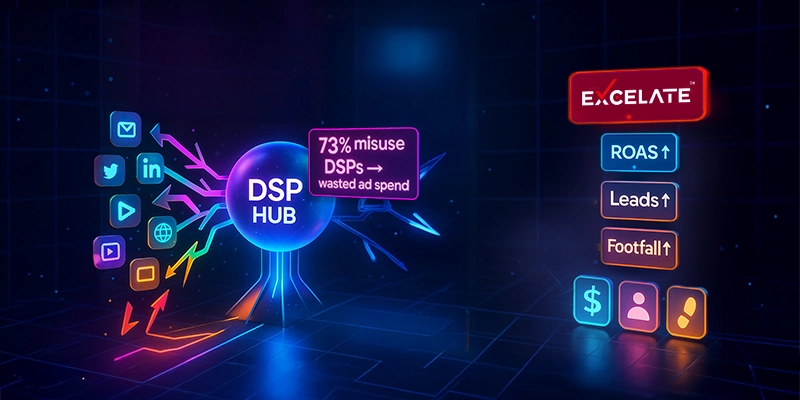Table of Contents
ToggleThe foundational principles of digital marketing are undergoing a seismic transformation, driven by the confluence of advanced artificial intelligence and a profound shift in consumer expectations. The strategies that defined the past decade based on broad segmentation, siloed channel management, and a passive approach to user experience are no longer sufficient. The 2025-26 landscape demands a new architecture for customer engagement, one built on real-time individualization, seamlessly orchestrated cross-channel journeys, and a deep, strategic integration of user experience as a core marketing function.
This new foundation is not an incremental evolution; it is a fundamental rewiring of how brands must connect with their audiences in an increasingly intelligent and discerning digital world. Success in this new era requires moving beyond buzzwords to operationalize personalization at a granular level, architecting a unified brand presence that builds trust through consistency, and recognizing that a superior user experience is the most sustainable driver of both customer satisfaction and organic visibility.
The Hyper-Personalization Imperative
The ept of „personalization“ has reached an inflection point, evolving from a marketing tactic into a strategic imperative. The era of addressing customers through static, predefined segments is being supplanted by a new standard: AI-driven, real-time individualization.
This paradigm shift is not merely about showing a user their first name in an email; it is about dynamically reshaping the entire customer journey to anticipate and serve individual needs with unprecedented precision. For brands, this represents both a significant technological challenge and a powerful opportunity to forge deeper, more resilient customer relationships.
The ability to move beyond reactive personalization to predictive, one-to-one engagement is what will separate market leaders from laggards in the 2025-26 ecosystem.
Beyond Segmentation: Real-time, AI-driven Individualization
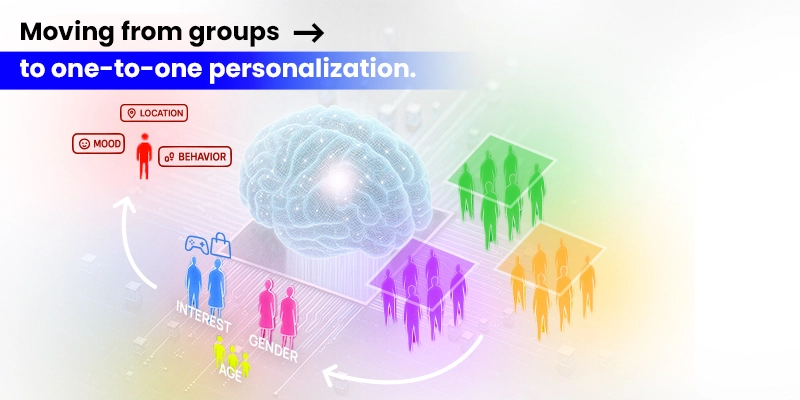
The core strategic shift in personalization is the move from static audience segments to dynamic, one-to-one experiences adapted in real-time. Artificial intelligence and machine learning are the engines of this transformation, capable of analyzing vast and complex datasets including behavioral patterns, historical data, and predicted preferences to tailor every aspect of a user’s journey. This approach transcends traditional product recommendations. It extends to the dynamic generation of marketing messages, the real-time adjustment of user interfaces, and even the creation of individualized product designs, all orchestrated to resonate at a granular level.
Generative AI represents the next frontier, elevating this capability from data-driven triggers to truly bespoke creative experiences. Instead of simply selecting a pre-approved message for a specific user profile, generative AI can create entirely new, individualized content, ad copy, and imagery at scale. This allows marketers to tailor not just the offer but also the tone, style, and visual elements of the communication to resonate more strongly with specific consumer subgroups and individuals, making the buying experience more convenient and enjoyable through greater relevance.
This advanced form of personalization is being applied across a diverse range of industries, demonstrating its versatility and impact:
- Retail and E-commerce: Brands are leveraging AI to present real-time product recommendations and implement dynamic pricing models that adjust based on live demand signals, maximizing revenue and aligning inventory with shopper profiles.
- Financial Services: Institutions are using AI-driven personalization for more accurate, individualized risk assessments, the creation of tailored investment portfolios, and enhanced fraud prevention, leading to better client retention and revenue growth.
- Healthcare and Wellness: Providers are exploring AI hyper-personalization to improve patient engagement through personalized health recommendations, customized treatment plans, and optimized resource allocation based on patient flow patterns.
However, this technological leap creates a fundamental tension. The very data required to fuel these sophisticated AI engines browsing habits, purchase history, social sentiments, and real-time behavioral patterns is becoming increasingly sensitive and subject to consumer and regulatory scrutiny.
A marketing strategy built solely on maximizing data collection without a clear value proposition is therefore unsustainable. The most successful brands in 2025-26 will be those that resolve this personalization-privacy paradox. This requires a strategic pivot from passively collecting data to actively demonstrating the tangible value a user receives in exchange for that data.
For example, a brand might explicitly state, „Allow us to use your browsing history to provide you with a personally curated storefront that saves you time and surfaces products you’ll love.“ This reframes the privacy conversation from a legal hurdle into a brand-building opportunity, establishing a foundation of „value-exchange transparency“ that fosters trust while enabling powerful personalization.
Predictive Analytics in Action: From Customer Needs to Product Innovation
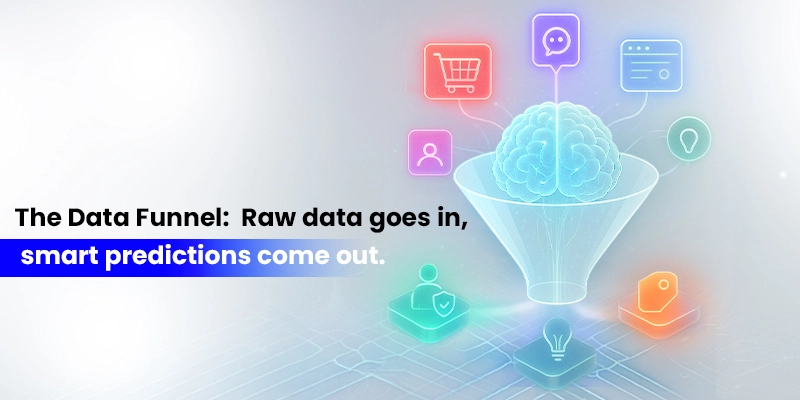
The true power of AI in marketing lies not just in its ability to react to past behavior but in its capacity to predict future actions. By analyzing vast datasets, sophisticated AI models can now forecast customer behavior with remarkable accuracy, identifying the likelihood of a customer to churn, respond to a specific promotion („promo propensity“), or engage with a particular piece of content („content propensity“). This predictive insight enables a proactive, rather than reactive, marketing posture.
Instead of waiting for a customer to become dormant, a predictive model can identify an infrequent buyer and automatically trigger a tailored offer that aligns with their historical purchasing frequency. Similarly, a model can identify a discount-sensitive customer who is exhibiting behaviors associated with competitor evaluation and proactively serve them a steeper promotion to prevent churn, recognizing that a smaller margin is preferable to losing a customer entirely.
These predictive capabilities are powered by advanced machine learning techniques like regression analysis, decision trees, and neural networks, which allow marketers to understand customer behavior at a deeper level and hyper-personalize deals and offers to shorten the sales cycle. Critically, these insights extend beyond the marketing department to inform broader business and product strategy.
By revealing hidden patterns and unmet needs within customer data, predictive analytics can guide product development, ensuring that resources are not wasted on features or services that users do not require. This creates a virtuous cycle where data-driven marketing insights lead to better product-market fit, which in turn generates more satisfied customers and richer data, further refining the predictive models. This strategic application of predictive analytics transforms the marketing function from a cost center focused on communication to a value driver that informs the core product and innovation roadmap of the entire organization.
Measuring the ROI of Granular Personalization
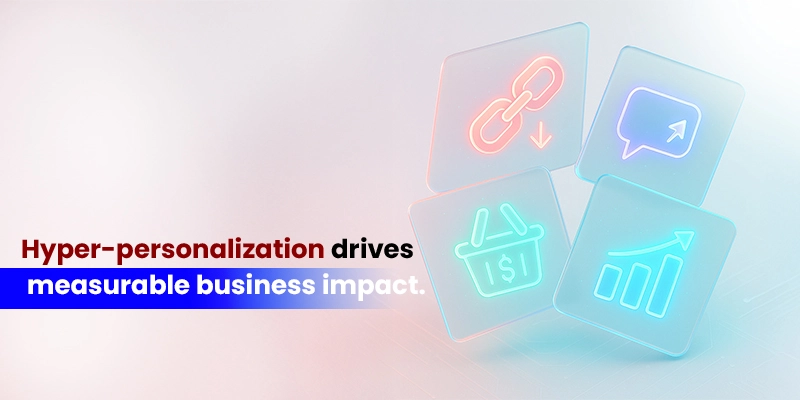
To justify the significant investment in technology and data infrastructure required for hyper-personalization, its impact must be measured with rigorous, business-centric metrics. The success of these initiatives cannot be gauged by vanity metrics alone; it must be tied directly to tangible business outcomes. Key performance indicators (KPIs) for evaluating the return on investment (ROI) of hyper-personalization include churn reduction, measurable increases in user engagement and customer retention, higher average order value (AOV), and, ultimately, a positive impact on overall profitability.
Advanced analytical models provide the tools for this sophisticated measurement. For instance, the concept of „promo uplift“ or „promo effectiveness“ allows marketers to move beyond simple attribution. By analyzing customer behavior during promotional periods versus non-promotional periods, these models can calculate the true incremental lift and ROI of a specific campaign, distinguishing between sales that would have happened anyway and those directly generated by the personalized offer.
Ultimately, the business case for hyper-personalization is built on two pillars: stronger customer loyalty and more efficient resource usage. By delivering tailored, relevant experiences that reduce friction and anticipate needs, brands can cultivate a loyal customer base that is less susceptible to competitive pressures. Simultaneously, by using predictive analytics to target specific needs and inform product development, organizations can prevent wasted expenditure and align their resources more effectively with market demand. When measured correctly, hyper-personalization is not just a marketing enhancement but a driver of operational efficiency and long-term enterprise value.
Architecting the Unified Customer Experience
In the complex digital ecosystem of 2025-26, customers do not perceive channels; they perceive a single brand. A disjointed experience where a social media interaction is disconnected from a follow-up email, or where the mobile app offers a different promotion than the website erodes trust and creates friction that drives customers away.
The strategic imperative, therefore, is to move beyond a simple „multichannel“ presence, where various platforms are used in isolation, to a truly integrated „cross-channel“ strategy. This involves architecting a unified customer experience where every touchpoint is connected, consistent, and contributes to a single, coherent customer journey. This requires not only a strategic commitment to brand consistency but also a robust technological foundation capable of unifying customer data from across the organization.
Cross-Channel Orchestration vs. Multi-Channel Presence
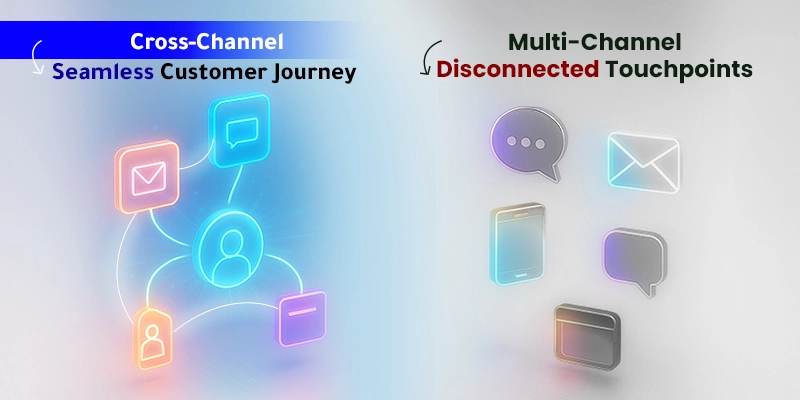
The distinction between multichannel and cross-channel marketing is critical for strategic planning. A multichannel approach is characterized by the use of various channels that operate in independent silos. A brand might have a presence on social media, send emails, and run a mobile app, but these channels do not communicate with each other. In contrast, cross-channel marketing is defined by its integrated nature. It is a strategic approach designed to create a cohesive and unified customer experience by connecting these channels, allowing for a seamless transition for the customer as they move between touchpoints.
The goal of cross-channel orchestration is to guide customers logically and contextually from one stage of their journey to the next. For example, a customer’s interaction with a brand on social media such as liking a post about a specific product can automatically trigger a follow-up communication via email or SMS that builds directly on that interaction, perhaps offering more information or a special promotion for that product. This creates a continuous, personalized conversation rather than a series of disconnected marketing blasts.
The business case for adopting a true cross-channel strategy is overwhelmingly positive. Empirical data demonstrates that integrated approaches yield significantly higher performance across key business metrics. Compared to single-channel efforts, cross-channel marketing strategies have been shown to generate 166% more engagement, achieve 24% higher conversion rates, and result in 23% higher revenue. Furthermore, with 90% of consumers now expecting consistent interactions across all touchpoints, a unified experience is no longer a competitive advantage but a baseline expectation.
The Role of Data Unification (CDPs) in a Consistent Brand Message
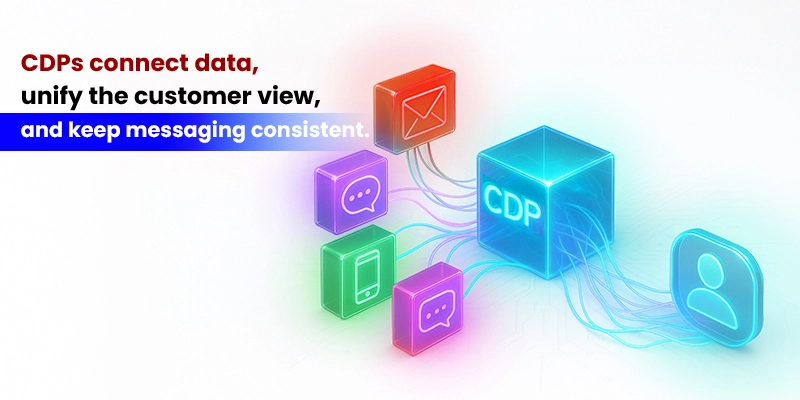
A successful cross-channel strategy is fundamentally impossible without a unified, 360-degree view of the customer. Achieving this requires a robust technological foundation capable of breaking down data silos and consolidating customer information from every touchpoint. This is the primary function of a Customer Data Platform (CDP), which serves as the central nervous system for a modern cross-channel marketing operation. A CDP ingests and unifies data from disparate sources including email marketing platforms, social media channels, mobile apps, customer relationship management (CRM) systems, and in-store interactions to create a single, persistent customer profile.5
This unified data foundation enables a level of strategic sophistication that is unattainable with siloed data. For example, marketers can create highly specific suppression lists, such as excluding customers who have recently given a low Net Promoter Score (NPS) from a promotional campaign to prevent contact fatigue and reduce the risk of churn.5 It also provides the data needed to ensure that messaging remains consistent and relevant as a customer moves from one channel to another.
However, technology alone is not sufficient. A consistent brand message also requires a non-technical, strategic tool: a comprehensive brand messaging guide. This document serves as the single source of truth for the brand’s identity, defining its voice, tone, visual style, and key talking points. By ensuring that everyone in the organization from marketing and design to sales and customer service is aligned on this guide, brands can prevent the kind of disjointed messaging that confuses customers and weakens brand perception.6
The intense focus on achieving cross-channel consistency and a unified brand message signals a significant strategic evolution. It marks a reaction against the fragmentation of the last decade, where channel-specific performance marketing often operated with little regard for the overall brand narrative, leading to a chaotic customer experience. The solution, a unified data platform combined with a central brand messaging guide represents a core tenet of classic brand management, now being reapplied to the digital landscape. This development suggests that the most valuable digital marketers in 2025-26 will be „brand-quant“ hybrids. They will require the quantitative and analytical skills to manage a CDP and interpret complex cross-channel performance data, but they will also need the strategic brand-building acumen to ensure the message being delivered is coherent, compelling, and consistent, regardless of the channel. Technology, in effect, is forcing a strategic reunification of brand and performance marketing.
Optimizing the Journey: From Mobile App Retargeting to CTV Integration
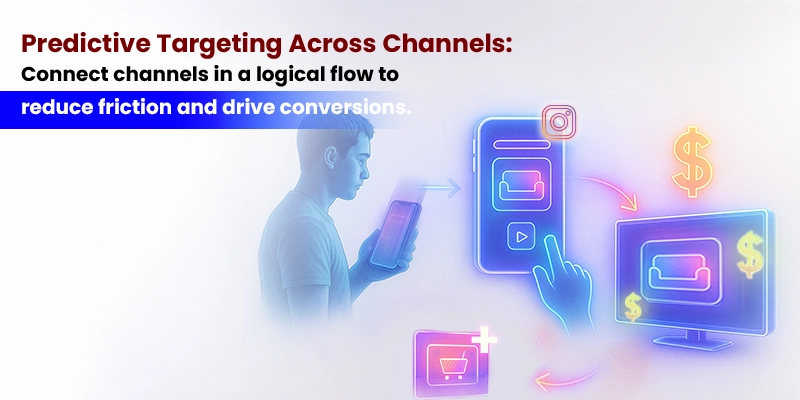
With a unified strategy and data foundation in place, execution must be tailored with channel-specific tactics designed to create a seamless and effective customer journey. For the 2025-26 timeframe, several key optimization strategies are emerging as particularly powerful:
- Mobile App Retargeting: Mobile apps are central to customer engagement, but user retention is a persistent challenge. A critical cross-channel tactic is to use predictive analytics to identify users who are likely to churn or who have become dormant. These users can then be targeted with personalized, behavior-based retargeting campaigns on other channels (such as social media or email) to bring them back into the app and increase their lifetime value.
- Connected TV (CTV) Retargeting: CTV offers a unique opportunity to bridge the gap between digital engagement and the high-impact experience of television advertising. By retargeting users on a large screen who have previously interacted with the brand on other devices for example, serving a CTV ad with a special offer to a user who abandoned a shopping cart on their mobile phone brands can create a powerful, cohesive omnichannel experience that reinforces messaging and drives conversions.
- Deep Linking: This is a crucial technical component for minimizing friction in the customer journey. A deep link allows a user to click on an ad or an email and be taken directly to a specific product page or piece of content within a mobile app, rather than to a generic mobile website. By eliminating unnecessary steps, deep linking significantly increases the likelihood of conversion and improves the overall user experience.
Furthermore, the creative assets themselves must be optimized for the specific context of each channel.
A one-size-fits-all approach to creative is no longer effective. For instance, a streaming service found that it could achieve a 35% lift in engagement by tailoring its ad formats: serving shorter, visually dynamic ads to mobile users who are often on the go, while delivering longer, more immersive, story-driven content to CTV viewers in a lean-back environment.
This requires a commitment to A/B testing and continuous optimization to determine what resonates best with the audience on each platform.
User Experience (UX) as a Core Marketing Function
The role of User Experience (UX) has fundamentally evolved, moving from a siloed web development concern to a critical, strategic component of the marketing function. In the 2025-26 digital landscape, a seamless, intuitive, and high-performing user experience is no longer a „nice-to-have“; it is a primary driver of brand perception, customer satisfaction, and, most importantly, conversion rates. Organizations that recognize and invest in UX as a core marketing discipline will build a sustainable competitive advantage, as a superior experience directly influences both customer loyalty and a brand’s visibility in an increasingly user-centric digital ecosystem.
The Business Impact of Performance, Intuitiveness, and Accessibility
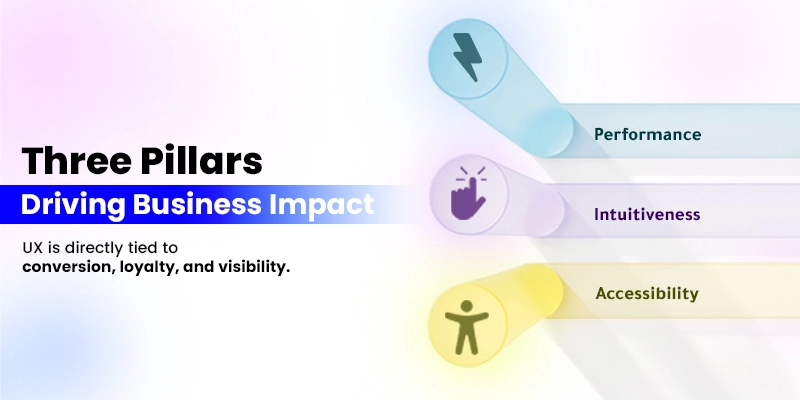
The integration of UX into the core of business strategy is evidenced by a clear shift in organizational behavior and investment priorities. UX research is no longer a peripheral activity but is now frequently initiated by product and marketing teams to inform the development of effective marketing strategies, detailed user personas, and comprehensive customer journey maps.
This strategic alignment is backed by significant financial commitment, with 72% of organizations reporting an increase in their UX expenditure over the last year. This investment is not speculative; it is directly tied to measurable business outcomes. The success of UX initiatives is now gauged by their direct impact on key performance indicators such as user satisfaction, the speed of product development, and, most critically for marketing, conversion rates.
The measurement of UX has also matured, moving toward more data-driven and standardized methodologies. The development of comprehensive benchmarking metrics, such as the ULX® Benchmarking Score, allows organizations to evaluate their user experience across multiple dimensions, including usability, appeal, trust, and performance.
These scores provide immediate, actionable insights and enable rigorous competitive benchmarking, transforming UX from a subjective design discipline into a quantifiable driver of business value. This evolution has profound implications for how marketing and technology teams must collaborate.
The principles of good User Experience are becoming inseparable from the principles of effective search optimization. In the past, Search Engine Optimization (SEO) was often a technical discipline focused on signals like keywords and backlinks. However, as search algorithms, particularly those powered by AI, become more sophisticated, they are increasingly designed to reward content and websites that best satisfy user intent.
The core tenets of good UX such as intuitive navigation, fast page load speeds, clear information architecture, and accessible content are precisely the factors that allow a user to find their answer quickly and efficiently. Consequently, a website with an excellent user experience is inherently more likely to perform well in an AI-driven search environment that prioritizes user satisfaction.
This convergence means that marketing teams must break down the traditional walls between their SEO/content functions and UX/design teams. Budgets allocated for UX improvements, such as enhancing site speed or implementing a more intuitive layout, should be viewed as direct and necessary investments in the brand’s long-term organic visibility.
Emerging UX/UI Paradigms for 2025
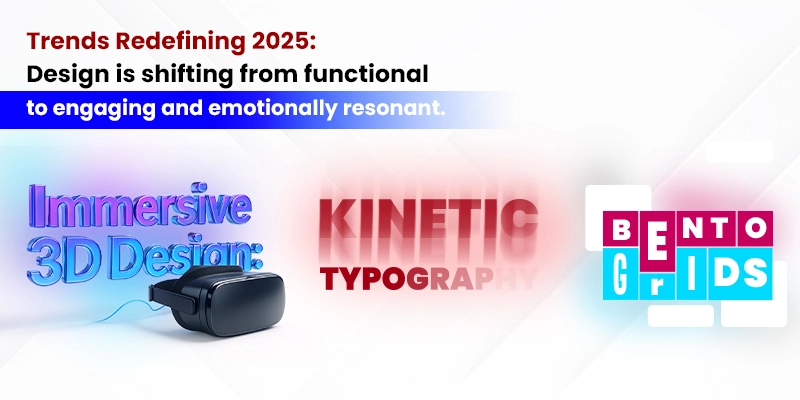
The field of digital design is undergoing a creative renaissance, shifting away from purely functional, utilitarian interfaces toward more thoughtful, engaging, and emotionally resonant digital experiences. This evolution is driven by both technological advancements and a deeper understanding of user psychology. For 2025-26, several key UX/UI trends are set to redefine how users interact with brands online:
- Immersive 3D Design: Propelled by the growing accessibility of Augmented Reality (AR) and Virtual Reality (VR) and increased browser processing capabilities, 3D elements are transitioning from aesthetic novelties to powerful functional enhancements. Immersive 3D design, with its realistic textures and fluid movements, adds a new layer of depth to interfaces. This enables highly interactive experiences such as 360° product views, which allow a customer to inspect an item from all angles, and virtual try-ons, which let a user see how a pair of glasses might look on their face or how a piece of furniture might fit in their living room. These features make the web feel more tangible and personal, bridging the gap between digital browsing and physical interaction.
- Kinetic Typography: This trend leverages motion as a core component of typographic design. By using techniques such as directional movement, color shifts, and dynamic size variations, kinetic typography can be used to capture a user’s attention, guide their eye to important information, and powerfully convey a brand’s personality. As technology advances, this trend is becoming more sophisticated, with AI-driven animations that can adjust the motion of text based on tone and context, creating a more dynamic and engaging reading experience.
- Bento Grids: Inspired by the compartmentalized Japanese bento box, this modular design trend organizes different sections and functionalities of an interface into distinct, visually clear containers. Initially popular for dashboards, the bento grid aesthetic is now being applied to websites and apps to improve clarity, allow for a more creative and visually engaging layout, and help users focus on the most important information by creating a strong visual hierarchy.
The Strategic Integration of Conversational AI and 24/7 Support
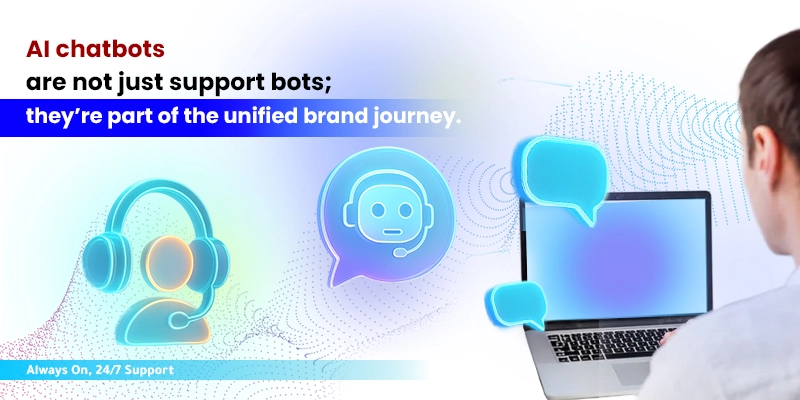
Conversational AI, primarily in the form of chatbots, has become an indispensable component of the modern user experience, providing immediate, 24/7 guidance and support that meets the expectations of today’s always-on consumer.6 However, the strategic role of these tools has evolved far beyond simply deflecting customer support tickets.
The latest generation of AI-powered chatbots is capable of hyper-personalized interactions. Powered by large language models (LLMs), these bots can engage in nuanced, context-aware conversations, address complex user queries, and actively nurture leads in real-time. By providing relevant information and personalized assistance at the moment of need, they play a crucial role in building stronger, more responsive customer relationships.
Strategically, chatbots serve as a vital connective tissue within a cross-channel experience. They act as a seamless bridge, helping users navigate between different parts of a website or app, providing instant answers to frequently asked questions, and, critically, intelligently escalating conversations to a human expert when necessary.6 This ensures that the user journey is never a dead end, providing a consistent and supportive experience that enhances trust and facilitates conversion.
Disruptive Forces and Emerging Channels
The digital marketing landscape is being reshaped by a series of powerful, disruptive forces that are fundamentally altering how consumers discover information, interact with brands, and make purchasing decisions.
The established paradigms of the last decade are giving way to a new ecosystem that is more conversational, community-driven, and immersive.This section analyzes the most significant of these disruptions, beginning with the profound shift in search behavior the move from a link-based web to an answer-based one.
It then explores the evolution of influence from celebrity endorsements to authentic, niche communities, and the rise of voice as a primary conversational interface. Understanding and adapting to these forces is not merely a matter of staying current; it is a prerequisite for survival and growth in the coming years.
The End of Search as We Know It: From SEO to AEO
For over two decades, Search Engine Optimization (SEO) has been the cornerstone of digital marketing, a discipline focused on the singular goal of achieving high rankings in a list of blue links.
That era is definitively ending. The rise of powerful, conversational AI is triggering the most profound shift in organic marketing since the advent of Google itself. The new paradigm is no longer about optimizing for a list of potential destinations; it is about optimizing to become the direct, AI-generated answer.
This requires a fundamental rethinking of content strategy, technical optimization, and the very definition of success in organic search.
The Rise of AI-Powered Search (SGE) and Conversational Queries
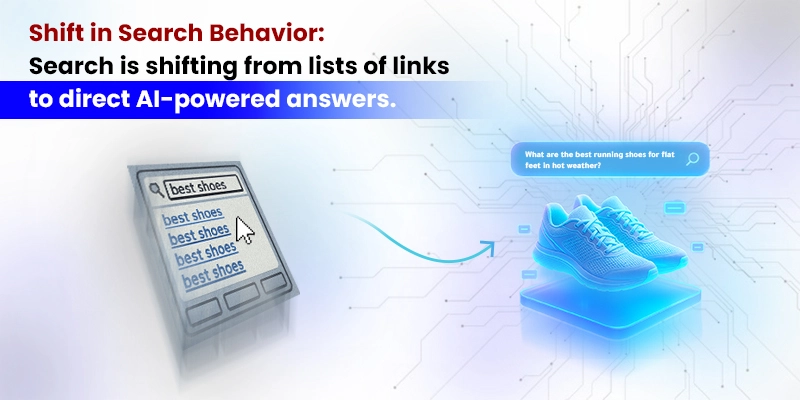
The digital marketing landscape of 2026 is projected to be one where traditional, keyword-driven search engines are increasingly supplanted by conversational AI interfaces such as Google’s Search Generative Experience (SGE), ChatGPT, Gemini, and Perplexity.
This technological shift is a direct response to an evolution in user behavior. Consumers are moving away from typing short, fragmented keywords and are instead asking longer, more complex, natural language questions. They expect a synthesized, direct answer to their query, not a list of links that they must then sift through to find the information they need.
This trend is giving rise to the „zero-click search,“ a phenomenon where a user’s query is fully answered directly on the search results page or within a chatbot interface, eliminating the need to click through to a website.
In this environment, traditional metrics like keyword rankings and even organic traffic become less reliable indicators of visibility and influence. The new measure of success is not whether a brand’s website is listed, but whether its content is used as the authoritative source
within the AI’s generated answer. This represents a fundamental redefinition of what it means to be visible online.
Answer Engine Optimization (AEO): A Practical Framework for Becoming the Cited Source
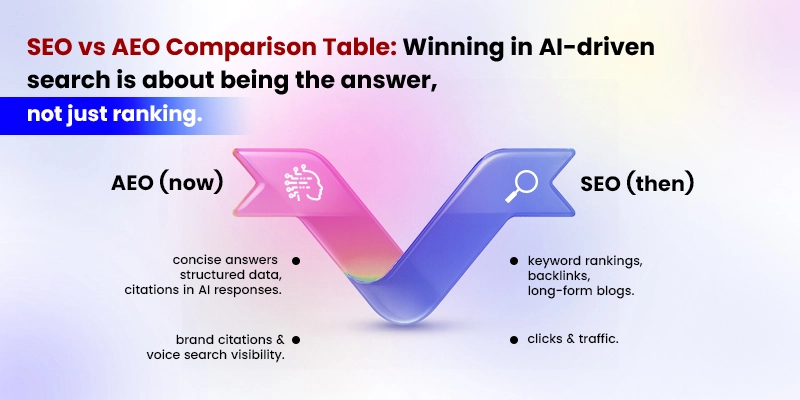
In response to this new reality, a new discipline is emerging: Answer Engine Optimization (AEO). AEO is the strategic process of creating and structuring content with the specific goal of enabling AI-powered platforms to directly extract and present it as an answer to a user query.
The primary objective of AEO is not to rank number one in a list of links, but to becited by the AI as the source of the answer, or to have one’s content form the basis of the AI’s synthesized response. AEO fundamentally differs from traditional SEO in its approach. It targets the conversational, long-tail questions that are characteristic of AI-driven search.
This requires a content strategy that moves beyond optimizing a single page for a single keyword. Instead, AEO demands the creation of comprehensive content that addresses clusters of related topics and answers numerous variations of a user’s potential questions.
The content formats best suited for AEO are those that provide direct, clear, and easily digestible information. These include:
- Frequently Asked Questions (FAQ) pages: These naturally align with the question-based nature of conversational search.
- Knowledge graphs and hubs: These are collections of interlinked content that demonstrate deep expertise on a particular topic.
- Concise explainers: These provide direct, succinct answers to specific questions, often structured to be between 40 and 60 words in length, making them ideal for extraction by AI models.
The following table provides a clear, side-by-side comparison of the strategic differences between traditional SEO and the emerging discipline of AEO, offering a framework for reallocating resources and redefining success metrics.
Criteria | SEO (Search Engine Optimization) | AEO (Answer Engine Optimization) |
Primary Goal | Ranking in a list of links | Being the cited source in an AI-generated answer |
Target Audience | Human users scanning a SERP | AI models/LLMs seeking direct answers |
Core Content Format | Long-form blog posts, landing pages | Concise FAQs, structured data, knowledge hubs |
Keyword Strategy | Focus on head terms and broad topics | Focus on conversational, long-tail, question-based queries |
Key Technical Signal | Backlinks, site speed | Schema markup, semantic structure, entity recognition |
Primary Success Metric | Organic traffic, keyword rankings, CTR | Brand citations, voice search visibility, featured snippets |
Example „Win“ | Ranking #1 for „best running shoes“ | Being the source for Siri’s answer to „What are the best running shoes for high arches?“ |
This framework highlights the necessity of a dual-focus strategy. While the principles of good SEO remain important for foundational visibility, a dedicated AEO strategy is now essential for capturing the growing volume of traffic and influence within AI-driven search environments.
The New Content Imperative: Semantic Depth, Structured Data, and E-E-A-T
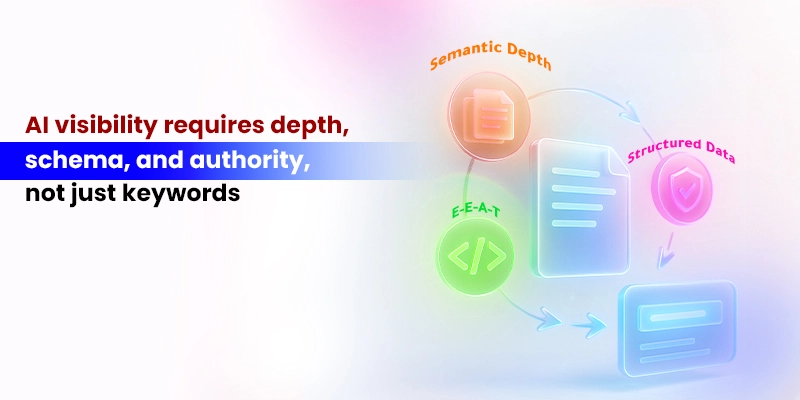
To succeed in an AEO-driven world, content must be architected for both human readers and machine comprehension. This requires a new content imperative focused on three key pillars: semantic depth, structured data, and demonstrated authority.
First, content must be „AI-friendly.“ This means it must be written in clean, natural language, be semantically rich (covering a topic and its related subtopics comprehensively), and be well-organized with a clear, logical hierarchy. The use of structural elements like headings (H2s, H3s), lists, and bullet points is no longer just a matter of good formatting; it is a critical signal that helps AI models parse, understand, and summarize the content effectively.9
Second, the implementation of Structured Data (Schema Markup) is an essential technical requirement. Schema is a vocabulary of tags that can be added to a website’s HTML to help search engines understand the context and meaning of the content on a page.
By implementing specific schema types such as FAQ schema for question-and-answer pages, How-to schema for instructional content, and Organization schema for business information brands provide explicit clues to AI models about the nature of their content. This significantly increases the likelihood that the content will be correctly interpreted and used as an authoritative source in a generated answer.9
Third, the concept of E-E-A-T (Experience, Expertise, Authoritativeness, and Trustworthiness) becomes more critical than ever. As AI models become the new gatekeepers of information, they are being trained to identify and prioritize sources that are credible and trustworthy.
Demonstrating E-E-A-T through author bios, citations of reputable sources, customer testimonials, and a strong overall digital footprint is crucial for being cited by an AI, especially for content related to „Your Money or Your Life“ (YMYL) topics such as finance and health.9
This new content imperative reveals a critical strategic vulnerability. As AI becomes increasingly proficient at answering factual, „what is“ questions by synthesizing information from multiple sources, the value of creating basic definitional content will diminish.
A brand whose entire content strategy is based on defining terms will find its content easily aggregated by an AI, often without a direct citation, effectively commoditizing its knowledge. The strategic value for brands will therefore shift to creating content that addresses more complex „why it matters“ and „how to do it“ queries. Content that provides proprietary insights, expert analysis („why this trend is important for your business“), detailed step-by-step tutorials („how to implement a successful AEO strategy“), and original research is much harder for an AI to simply synthesize.
This type of high-value content is more likely to require a direct citation to the trusted source, as the value lies in the unique perspective and expertise, not just the raw facts.11 This necessitates an evolution in content strategy, moving from a „topic coverage“ model to a „proprietary value“ model.
The guiding question for marketers must become: „What unique perspective, data, or experience can our brand provide that an AI cannot simply scrape and summarize from the existing web?“ This elevates the importance of thought leadership, original research, and expert-driven analysis as the core of a future-proof content strategy.
The Evolution of Influence and Community
The landscape of influence marketing is undergoing a significant maturation, moving away from the high-cost, low-authenticity model of celebrity endorsements toward a more nuanced, community-centric, and performance-driven approach. In the 2025-26 ecosystem, trust is the most valuable currency, and it is most effectively built through authentic connections with niche audiences. This has led to the strategic rise of micro and nano-influencers, the adoption of compensation models that directly tie influencer activity to business outcomes, and a growing emphasis on interactive and immersive content that transforms passive audiences into active communities.
The Strategic Shift to Micro and Nano-Influencers
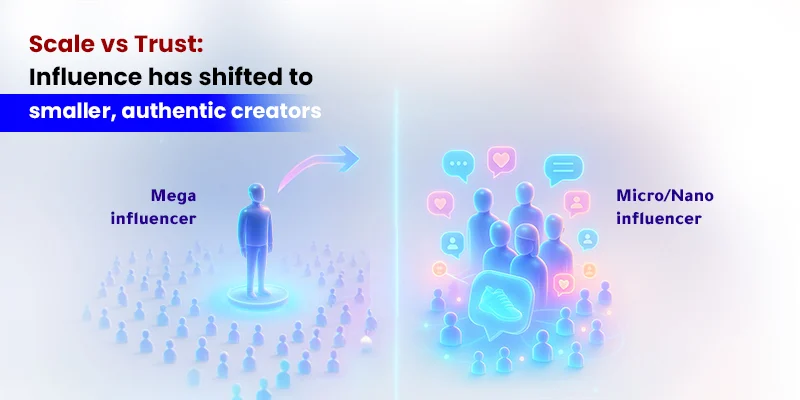
In an era of heightened consumer skepticism, authenticity and trust have become the paramount virtues in influencer marketing. This has led to a strategic pivot away from mega-influencers and celebrities toward micro-influencers (typically defined as having 15,000 to 75,000 followers) and nano-influencers (fewer than 15,000 followers).15 These smaller-scale creators are favored because they have cultivated genuine, personal connections with their audiences.
Their recommendations are often perceived not as commercial endorsements, but as trusted advice from a knowledgeable peer or friend.16
The data supports this strategic shift. Micro-influencers have been shown to generate engagement rates up to 60% higher than their larger counterparts, making their content more impactful in terms of influencing purchasing decisions.
This has prompted a significant reallocation of marketing budgets. Instead of investing a large sum in a single, high-cost celebrity partnership, savvy brands are now dividing their funds among a portfolio of multiple smaller creators. This approach allows them to support lower-funnel campaign strategies, build lasting impact within niche communities, and achieve a higher overall return on their influencer marketing investment.15
Performance-Based Partnerships: Aligning Creator Incentives with Business Outcomes
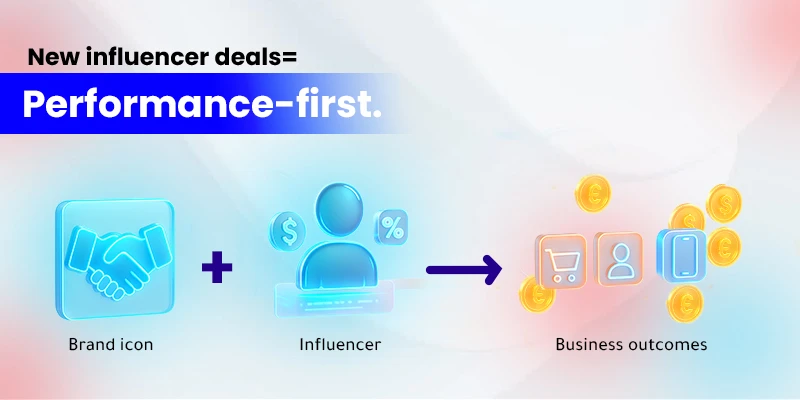
Coinciding with the shift to smaller creators is a definitive move away from traditional, flat-fee payment models toward performance-driven partnerships that focus on commissions and measurable business results.15 Brands are no longer content to pay for potential reach; they are demanding tangible outcomes and are structuring their influencer collaborations accordingly.
Hybrid compensation models are rapidly becoming the industry standard. These models are designed to align the creator’s incentives directly with the brand’s business goals and can take several forms:
- Base Fee Plus Commission: A model that provides the creator with a guaranteed smaller payment for their time and effort, supplemented by a commission on any sales they drive.
- Tiered Commission Rates: A structure where the commission percentage increases as the creator achieves higher sales volumes, providing a powerful incentive for continued promotion.
- Multi-Action Compensation: A more sophisticated model that rewards creators for a variety of conversion activities beyond just the final sale, such as generating qualified leads, driving email sign-ups, or encouraging app downloads.
This shift to performance-based partnerships necessitates a more sophisticated approach to measurement. Brands must move beyond vanity metrics like likes and follower counts and implement robust tracking systems to monitor the true business impact of their influencer campaigns.
Key performance indicators now include conversion rates, average order value (AOV) from creator-driven traffic, customer acquisition cost (CAC) compared to other channels, and the overall return on ad spend (ROAS) for any paid amplification of creator content.
From Content to Commerce: The Power of Interactive and Immersive Experiences
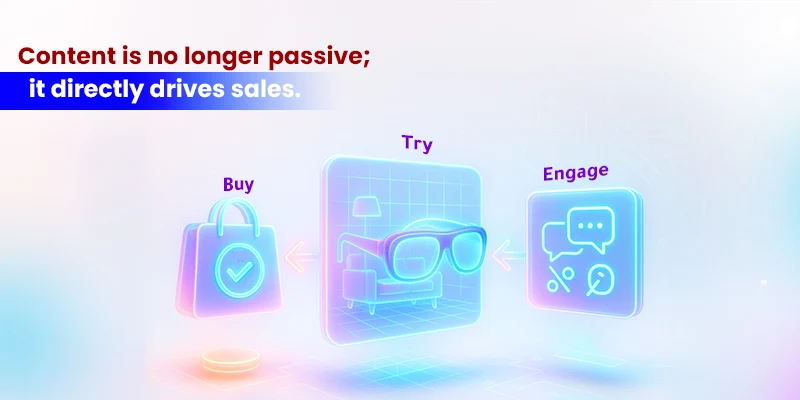
The nature of content itself is evolving from a passive medium to an active, engaging experience. The rise of interactive content such as quizzes, polls, calculators, assessments, and interactive videos has been proven to significantly boost user engagement and drive higher conversion rates.
Data shows that interactive content can engage users for two to three times longer than traditional static content, providing a richer and more memorable brand experience. Examples of effective interactive content are now prevalent across industries:
- Calculators: A financial services firm might offer a loan or mortgage calculator that provides immediate, personalized value to a user while also capturing them as a highly qualified lead.17
- Assessments: A B2B software company like HubSpot can use a „Website Grader“ tool to provide a potential customer with a personalized assessment of their website’s performance, highlighting areas where their products could provide a solution.
- Product Configurators: An e-commerce brand like Nike allows users to design their own custom shoes, an engaging experience that reduces purchase anxiety and often leads to a higher average order value.
- Interactive Video: A company like Deloitte can use an interactive recruitment video that allows candidates to choose different scenarios, simulating what it would be like to work at the firm and helping them self-qualify for a role.
This trend is being further accelerated by the integration of immersive technologies like Augmented Reality (AR) and Virtual Reality (VR). AR allows a customer to use their smartphone to see how a new piece of furniture would look in their living room or to virtually try on a pair of glasses, creating a powerful and highly engaging „try before you buy“ experience that bridges the physical and digital worlds.
The convergence of these trends the shift to performance-based partnerships, the emphasis on creator authenticity, and the rise of interactive and shoppable content is leading to a profound transformation of the role of the influencer.
The influencer is no longer merely an advertiser; they are becoming a fully-fledged, distributed sales channel for the brand. This evolution is driven by a powerful combination of factors. First, the commission-based compensation models treat influencers as sales partners with a direct incentive to drive revenue.
Second, social media platforms are increasingly integrating e-commerce features, enabling frictionless, one-click purchasing directly from creator content.15 Third, the inherent trust that micro-influencers have built with their niche communities makes their product recommendations highly effective at driving conversions.
When these three elements are combined a trusted recommendation, a direct incentive to sell, and a frictionless path to purchase the influencer ceases to be just a marketing asset. They effectively become a „micro-franchisee“ or a distributed digital storefront for the brand.
This requires a complete rethinking of the influencer relationship management function. It is no longer sufficient to focus on campaign briefs and content approval. Instead, brands must provide their influencer partners with the tools, data, and support they need to sell effectively, much like they would manage a traditional distributed sales team.
This includes providing real-time sales analytics, seamless inventory management, and creator-specific discount codes to empower them as true commerce partners.
Voice Search: The Conversational Interface
Voice search represents one of the most significant shifts in user behavior in recent years, transforming how consumers interact with technology to find information, discover local businesses, and make purchases.
Fueled by the widespread adoption of smart speakers and the increasing sophistication of voice assistants like Siri, Alexa, and Google Assistant, voice is rapidly becoming a primary conversational interface.
For marketers, this trend necessitates a dedicated strategy that goes beyond traditional SEO, requiring a deep understanding of the unique characteristics of voice queries and a commitment to the technical and content optimizations needed to achieve visibility in an audio-first world.
Optimizing for "How," "What," and "Near Me": The New Keyword Strategy
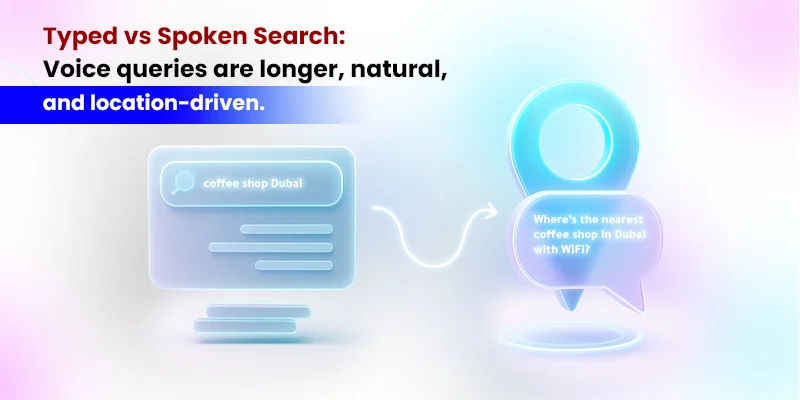
The growth of voice search is staggering, with some projections indicating that it will account for over 50% of all online searches by 2025. This surge is driven by the sheer convenience of hands-free operation, which appeals to multitaskers and on-the-go users, and the increasingly personalized experiences offered by voice assistants.
Critically, voice queries are fundamentally different from their typed counterparts. They are significantly longer, with the average voice search query containing around 29 words, and are more conversational in nature. Users tend to speak in full sentences and often phrase their queries as questions, typically starting with words like „who,“ „what,“ „when,“ „where,“ „why,“ and „how“.
A dominant characteristic of voice search is its strong local intent. An estimated 58% of consumers use voice search to find information about local businesses, and „near me“ searches have grown exponentially year over year.
This requires a shift in local SEO strategy from targeting broad geographic terms to optimizing for hyper-local, neighborhood-level queries. For example, a successful voice search strategy would target a phrase like „coffee shop in Wicker Park with free WiFi“ rather than the more generic „coffee shop Chicago“.
Voice Search: The Conversational Interface
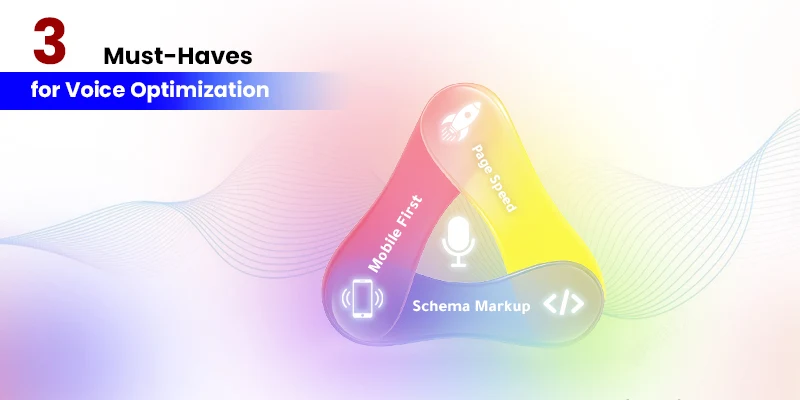
Achieving visibility in voice search results is heavily dependent on a strong technical foundation. Voice assistants prioritize websites that deliver a fast, seamless, and secure user experience. Several technical factors are non-negotiable for voice readiness:
- Page Speed: This is arguably the most critical technical factor. The average voice search result page loads in 4.6 seconds, which is 52% faster than the average webpage. A fast-loading site is a primary ranking signal for voice assistants, and pages that load in under three seconds are significantly more likely to be featured in voice search results.8
- Mobile Optimization: The vast majority of voice searches are conducted on smartphones and other mobile devices. Therefore, a mobile-first design and a fully responsive website are essential prerequisites for any voice search optimization strategy.
- Structured Data (Schema): Implementing structured data markup is crucial for helping voice assistants understand the content and context of a webpage. Using specific schema from schema.org for local business information (such as address, phone number, and hours of operation), FAQs, and how-to content provides clear, machine-readable information that makes it easier for a voice assistant to identify and present a site’s content in response to a query.
The Path to Voice Commerce
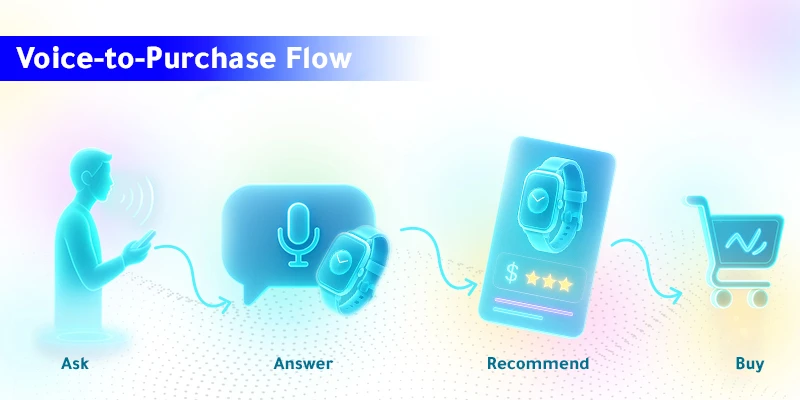
Beyond information retrieval, voice is emerging as a significant new channel for commerce. Voice-enabled purchasing, or „v-commerce,“ is projected to become an $80 billion annual market by 2025, creating a substantial new revenue stream for businesses that can effectively optimize for it.
To capitalize on this trend, e-commerce businesses must adapt their content and technical strategies. This includes using natural, conversational language in product descriptions that aligns with how users might ask about a product. Implementing product schema markup is also essential to provide voice assistants with detailed, structured information about products, including price, availability, and reviews.
A key content strategy for both informational voice search and voice commerce is to optimize for „Featured Snippets.“ These are the concise, direct answers that often appear at the top of Google’s search results in a special box. Voice assistants frequently pull their spoken answers directly from these snippets. To win a featured snippet, content should be structured to provide a clear, direct answer immediately following a question-based heading. This answer-first content format is highly favored by the algorithms that power both voice assistants and AI-generated search results.
The close alignment between the requirements for voice search and the principles of Answer Engine Optimization (AEO) is not a coincidence. Voice search can be seen as the ultimate expression of AEO. The core requirements for success in voice search providing direct, concise answers; structuring content in a question-and-answer format; using natural, conversational language; and having strong technical foundations like page speed and schema are identical to the requirements for success in AEO for text-based chatbots and AI-generated summaries. The only significant difference is the output medium (audio versus text).
This realization should lead to a simplification of strategy. Instead of creating separate, siloed strategies for „Voice SEO“ and „AEO,“ marketers should adopt a single, unified „Answer Optimization“ strategy. By focusing all efforts on the fundamental goal of creating the best, most direct, and most clearly structured answer to a user’s query, brands will simultaneously optimize their content for voice assistants, AI overviews like SGE, and conversational chatbots. This unified approach concentrates resources on the highest-impact activity: creating user-centric, answer-first content that is ready for the conversational future of the web.
The Marketer's Technology and Data Stack for 2025-26
Executing a modern digital marketing strategy is no longer possible without a sophisticated and deeply integrated technology and data stack. In the 2025-26 landscape, artificial intelligence has evolved from a specialized tool into the central nervous system of the entire marketing function, automating complex tasks, generating profound insights, and enabling personalization at a scale that was previously unimaginable.
This section provides a comprehensive guide to the essential technologies and data strategies required for success. It begins by framing AI as the underlying operating system for marketing, then delves into the AI-powered transformation of paid media platforms, and concludes with a critical examination of the most valuable and challenging asset in the modern marketer’s toolkit: data, and the imperative to build a strategy on the non-negotiable foundation of trust and privacy.
AI as the Central Nervous System of Marketing
لم يعد الذكاء الاصطناعي إضافة أو وظيفة متخصصة داخل التسويق؛ بل أصبح نظام التشغيل الأساسي للتخصص بأكمله. تكامله منتشر، حيث تستخدم أكثر من 75% من المؤسسات الآن الذكاء الاصطناعي في وظيفة عمل واحدة على الأقل.
لا يتم إطلاق القيمة الحقيقية للذكاء الاصطناعي من خلال تطبيقه على العمليات الحالية، ولكن من خلال إعادة تصميم سير العمل بشكل أساسي ليكون „الذكاء الاصطناعي أولاً“. في التسويق، يعمل الذكاء الاصطناعي كجهاز عصبي مركزي، حيث يقوم بأتمتة التنفيذ، وتوليد رؤى تنبؤية، وتمكين مستوى من إشراك العملاء المخصص الذي يعيد تشكيل المشهد التنافسي.
A Strategic Overview of AI Applications
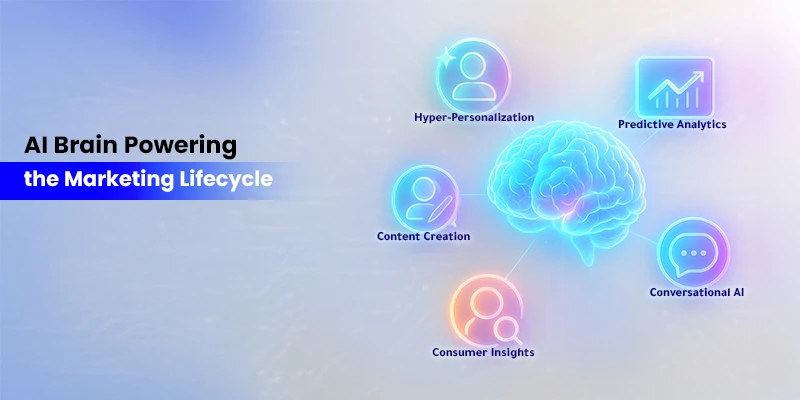
The applications of AI in marketing are broad and transformative, touching every aspect of the customer lifecycle. A strategic understanding of these applications is essential for building a modern, effective marketing organization. Key areas where AI is delivering significant value include:
- Hyper-Personalization: AI enables the real-time delivery of personalized content, product recommendations, and offers based on a deep analysis of user behavior, preferences, and past interactions.
- Content Creation: Generative AI tools like ChatGPT and Jasper are being used to create first drafts of blog posts, social media captions, and ad copy in seconds, dramatically increasing the speed and scale of content production.22
- Predictive Analytics: AI models can analyze vast datasets to predict future trends, forecast customer behavior (such as churn or purchase intent), and anticipate campaign outcomes, allowing for more strategic resource allocation.
- Conversational AI: AI-powered chatbots provide 24/7 customer support, answer complex queries, and assist in the purchasing process, improving customer satisfaction and generating qualified leads.
- Consumer Insights: Advanced AI tools like GWI Spark can analyze massive consumer datasets to provide real-time, data-backed insights into audience sentiment and behavior, enabling marketers to craft more resonant and effective strategies.
The following table provides a strategic framework for understanding the modern marketer’s AI toolkit, categorizing key tools by their primary function and outlining their strategic use case.
Category | Tool Example(s) | Primary Function | Strategic Use Case |
Consumer Insights | GWI Spark, Brandwatch | Real-time market research and social listening | Understanding audience sentiment and identifying emerging trends before they peak to inform campaign messaging |
Content Creation (Text) | Jasper AI, ChatGPT | Generating drafts of ad copy, blog posts, and emails | Scaling content production and rapidly testing messaging variations to find the most effective copy |
Content Creation (Visual) | Canva (AI features), Lumen5 | Creating social media graphics and turning written content into videos | Reducing reliance on specialized design teams for day-to-day content and making video marketing more accessible |
Hyper-Personalization & Data Management | Adobe Experience Platform, Salesforce Customer 360 | Unifying customer data to deliver personalized experiences in real-time | Architecting a true cross-channel strategy where interactions on one platform inform the messaging on another |
Ad Campaign Management | Google Ads (PMax/AI Max), The Trade Desk | Automating ad bidding, targeting, and creative optimization across multiple channels | Moving the marketing team’s focus from manual campaign adjustments to strategic input and performance analysis |
Email & Marketing Automation | ActiveCampaign, Klaviyo | Automating behavior-based email sequences and lead nurturing workflows | Nurturing leads at scale with personalized communication, increasing conversion rates and efficiency |
This toolkit demonstrates how AI is not a single solution but a suite of capabilities that, when integrated, can create a highly intelligent and efficient marketing operation.
Mastering AI-Powered Search Engine Marketing (SEM)
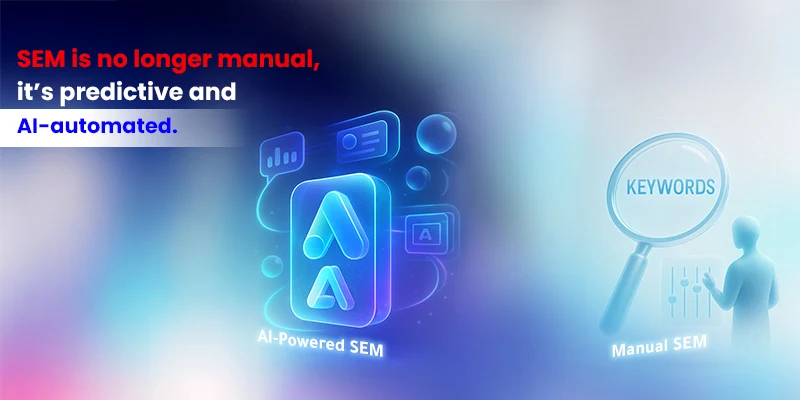
Nowhere is the impact of AI more pronounced than in the realm of Search Engine Marketing (SEM). The major advertising platforms, particularly Google Ads and Microsoft Advertising, have fundamentally re-architected their systems around AI, which now serves as the core component handling nearly every stage of a campaign, from targeting and bidding to creative development and optimization.24
The New Campaign Paradigm: Performance Max and AI Max Deep Dive
The evolution of campaign types on these platforms reflects a clear „AI-first“ trajectory. The two most significant developments are Google’s Performance Max (PMax) and the newer AI Max for Search.
- Performance Max (PMax): Launched as Google’s flagship AI-powered ad solution, PMax is a fully automated, goal-based campaign type. From a single campaign, advertisers can reach users across the entire Google ecosystem, including Search, Display, YouTube, Gmail, and Discover. The PMax system automatically handles ad placements, budget allocation, and messaging, using machine learning to optimize for the advertiser’s specified conversion goals.24
- AI Max for Search: Rolled out in beta in May 2025, AI Max is a new suite of AI-powered features designed to enhance traditional Search campaigns. A key distinction from PMax is that AI Max is not a „black box.“ It is designed to preserve the granular control and reporting transparency that advertisers value in Search campaigns while introducing sophisticated AI-driven automation.26 Key features of AI Max include:
- Search Term Matching: This feature expands a campaign’s reach beyond its explicitly targeted keywords. The system analyzes the advertiser’s existing keywords, creative assets, and landing page content to identify new, relevant, and high-performing search queries that the advertiser might have otherwise missed.27
- Asset Optimization: This includes two components. „Text customization“ dynamically generates new headlines and descriptions based on the user’s search intent and the content of the landing page. „Final URL expansion“ directs users to the most relevant page on the advertiser’s website for their specific query, improving the user experience and conversion potential.
Early performance data for AI Max is compelling. Advertisers who activate the feature suite are seeing, on average, 14% more conversions at a similar cost per acquisition (CPA). For campaigns that have historically relied heavily on exact and phrase match keywords, the performance uplift can be as high as 27%.26
Adaptive Bidding, Predictive Targeting, and AI-Generated Creative
Beyond new campaign types, AI is transforming the core mechanics of SEM in three critical areas:
- Targeting: The focus of targeting has shifted decisively from keywords to audiences. AI now uses predictive audience modeling, which combines a vast array of signals including historical search behavior, website interactions, app activity, YouTube watch patterns, and real-time purchase intent signals to identify the most valuable users to target. In this new paradigm, the quality and accuracy of an advertiser’s first-party data, which is used to „train“ the AI, has become the single most important factor for successful targeting.25
- Bidding: The „Smart Bidding“ strategies of the past have evolved into „Adaptive Bidding.“ This new generation of bidding algorithms is powered by predictive modeling and ingests a wide range of real-time market signals, including macroeconomic data, competitor bidding activity, and emerging consumer trends. This allows the system to adjust bids instantly in response to shifts in market demand, creating a more responsive but also more volatile bidding environment.25
- Creative: AI has become a powerful creative partner. Google’s Gemini model can now dynamically rewrite ad copy in real-time to be more relevant to a user’s specific query.25 On the Microsoft Advertising platform, tools like Ads Studio and Copilot allow advertisers to generate multiple ad variations, images, and even videos from simple natural language prompts. This accelerates the creative process and enables a level of hyper-personalized messaging that was previously impossible to achieve at scale.
The pervasive automation of SEM’s core tactical functions, bidding, targeting, and creative generation is creating a significant bifurcation in the role of the paid media specialist. The traditional „levers“ that specialists used to pull are being automated, shifting the focus of the role. The success of AI-driven systems like PMax and AI Max is now critically dependent on the quality of the inputs provided by the advertiser: clear business goals, high-quality first-party data, well-structured creative assets, and accurate conversion values.
This means the most important job is no longer managing the campaign in the traditional sense, but feeding the algorithm. This requires a more strategic skillset: the ability to define the right conversion goals that align with the business’s profit and loss statement, the technical acumen to ensure clean data flows from the CRM to the ad platform, and the creative and brand strategy skills to develop a strong brand voice and high-quality assets for the AI to model.
This suggests a necessary restructuring of marketing teams. The future-proof paid media professional is not the individual who has memorized every setting in the Google Ads UI, but rather the strategist who understands the business’s financials, can ensure data integrity, and can craft a compelling creative brief.
Companies that continue to hire and train for purely tactical, platform-specific skills will find those skills rapidly automated, while those who cultivate strategic, data-centric, and creative talent will gain a significant competitive advantage.
Leveraging Advanced Analytics and Automation Platforms

To effectively manage and optimize an AI-driven marketing strategy, organizations must invest in two other critical categories of technology: advanced analytics platforms and marketing automation tools. These platforms provide the data-driven insights and workflow efficiencies necessary to make informed decisions and execute personalized campaigns at scale.
Advanced Analytics Platforms: In an environment where data is the fuel for every AI model and strategic decision, a robust analytics platform is non-negotiable. The market offers a range of solutions tailored to different organizational needs and priorities:
- Usermaven: This platform is emerging as a strong choice for businesses seeking a balance between analytical depth and user-friendliness. It is an all-in-one, privacy-friendly solution that provides insights across the full customer journey, from acquisition to retention, without resorting to data sampling, which can distort results.34
- Google Analytics 4 (GA4): As the most widely used analytics tool globally, GA4 is an essential component of the stack for any organization heavily invested in the Google ecosystem, particularly those running large-scale ad campaigns. While its free access is a major advantage, teams must be prepared for its steep learning curve and the technical resources required to extract meaningful insights.34
- Adobe Analytics: This is an enterprise-grade solution designed for large organizations with complex, cross-channel data analysis needs. It offers powerful, granular control over data and deep integration with the broader Adobe Experience Cloud, making it ideal for businesses in data-rich sectors like retail, finance, and media.34
- Business Intelligence (BI) Tools: Platforms like Microsoft Power BI and Tableau play a crucial role in the analytics stack by enabling advanced data visualization. These tools are designed to turn raw data from multiple sources into meaningful, interactive dashboards and reports that can inform high-level strategic decisions.
Marketing Automation Tools: These platforms are the engines of execution, allowing marketers to automate and scale personalized communication across various channels. They are crucial for tasks like lead nurturing, automated email marketing, and social media scheduling. Key players in this space include:
- HubSpot: A highly popular all-in-one platform that combines a powerful CRM with a comprehensive suite of marketing automation tools, making it a central hub for many marketing and sales operations.37
- Klaviyo: A leading tool in the e-commerce space, Klaviyo specializes in sophisticated email and SMS automation that is deeply integrated with major e-commerce platforms like Shopify.38
- ActiveCampaign: This platform is known for its powerful combination of email marketing, advanced marketing automation, and built-in CRM features, allowing for highly personalized and behavior-driven customer journeys.
The strategic selection and integration of these analytics and automation platforms are what enable a marketing organization to translate the insights generated by AI into effective, scalable, and measurable actions.
The Trust Economy: Data Privacy as a Brand Differentiator
In the digital economy of 2025-26, consumer trust has emerged as the most valuable and most fragile asset a brand can possess. The era of opaque data collection and unchecked user tracking is over, replaced by a new reality defined by stringent regulations, heightened consumer awareness, and a growing demand for transparency and control.
In this new „trust economy,“ data privacy is no longer a legal burden or a compliance checkbox to be managed by the IT department. Instead, it has become a central pillar of marketing strategy and a powerful opportunity for brand differentiation.
Brands that lead with transparency, embrace ethical data practices, and empower their customers with control over their information will build the deep, resilient relationships that are the foundation of sustainable growth.
Navigating the Evolving Regulatory Landscape

The global regulatory landscape for data privacy continues to evolve and tighten. Foundational regulations like the EU’s General Data Protection Regulation (GDPR) and the California Consumer Privacy Act (CCPA) have set a high bar for data protection, and they are now being joined by a new wave of even more comprehensive frameworks.
These include the EU’s AI Act, which governs the use of personal data in artificial intelligence systems, and the Digital Markets Act (DMA) and Digital Services Act (DSA), which impose new obligations on large online platforms.
A common thread runs through all of these regulations: a mandate for greater transparency and a requirement for explicit, informed consent for the collection and use of personal data. Marketers are now legally obligated to be able to clearly and simply explain to consumers what data is being collected, why it is being collected, and how it will be used.39 Failure to comply is not a minor infraction.
The penalties for non-compliance can be substantial, including significant fines and legal action. Perhaps more damaging, however, is the irreparable harm that a privacy violation can do to a brand’s reputation and the trust it has built with its customers.
Implementing "Privacy-Led Marketing": A Framework for Transparency and Consent
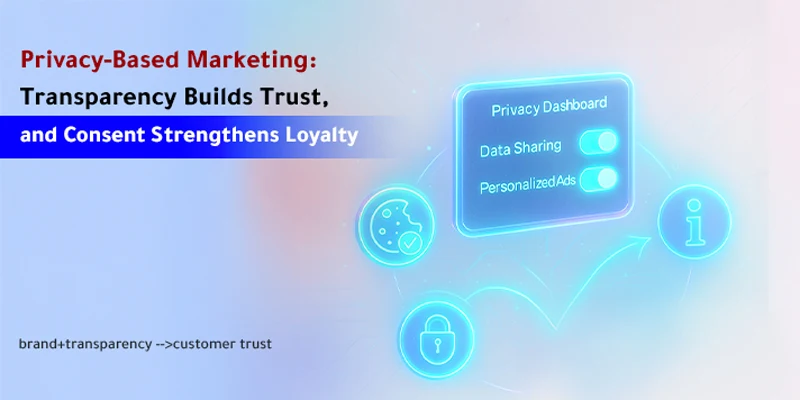
In response to this new reality, a strategic framework known as „Privacy-Led Marketing“ is emerging. This approach represents a fundamental shift in mindset, moving away from viewing privacy as a defensive compliance issue and toward proactively using it as a competitive advantage to build consumer trust.43
The core insight of Privacy-Led Marketing is that consumers are not rejecting personalization or innovation; they are rejecting opacity. They want to feel „seen, not surveilled“.44 Data shows that 44% of consumers state that transparency about how their data is used is the single most important factor in earning their trust.43 This demands a complete redesign of the consent experience. The cookie banner, once a legal afterthought, has become the new „front door“ to the brand.
Research reveals that 42% of consumers now actively read cookie banners, and 46% are accepting cookies less often than they did in the past.44 This is not passive behavior; it is intentional. Therefore, this critical first touchpoint must be treated with the same strategic care as a landing page. It should be clear, helpful, and consistent with the brand’s voice and values, transforming a legal requirement into a powerful, trust-building moment.43
This strategic approach has the potential to turn a perceived weakness into a strength. The most advanced companies will stop treating privacy as a legal policy buried in the footer of their website and will start actively marketing it as a core product feature, just as they would market speed, design, or functionality.
There is a clear and unmet set of user needs around privacy: 44% of consumers demand transparency, 43% expect strong security guarantees, and 41% want real, granular control over what they share.43 In product development, when such a clear set of user needs is identified, companies build features to meet them.
Therefore, privacy should be treated as a feature set. This means going beyond a legal policy page to create tangible, user-facing tools: a „Privacy Dashboard“ where users can easily see and control their data; clear, in-context notifications that explain why a piece of data is being requested at the moment it is needed; and simple, intuitive toggles for opting in or out of specific data uses. This creates a new dimension for brand competition.
Just as brands compete on price or quality, they will begin to compete on privacy. Marketing campaigns will actively highlight these „privacy features“ as a compelling reason to choose their brand over a competitor. The brand that can confidently and transparently say, „We collect less data,“ or „We give you more control,“ will have a powerful and sustainable competitive advantage in the trust economy of 2025-26.
Building Resilient Strategies with First-Party Data and Ethical Collection
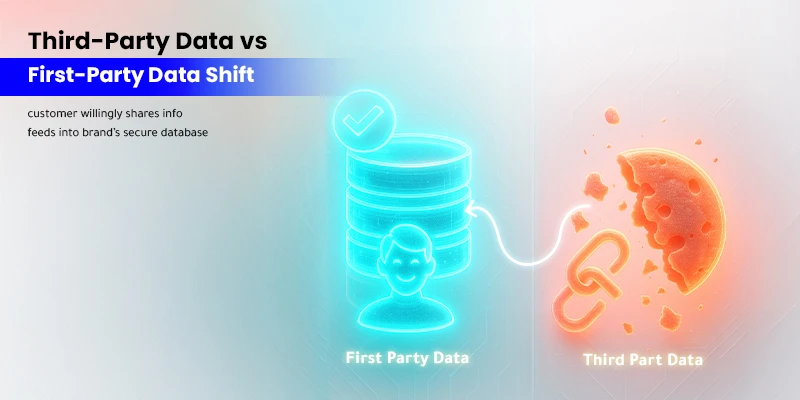
The dual pressures of stricter regulations and the deprecation of third-party cookies by major browsers have made a reliance on third-party data an increasingly risky and unsustainable strategy. The clear strategic imperative for marketers is to shift their focus to the collection and effective leveraging of first-party data.
First-party data is information that a company collects directly from its customers with their consent. This includes data from website visits, email sign-ups, purchase history, and interactions with a CRM system. Because it is collected directly, it is generally more accurate and, when handled correctly, more compliant with privacy regulations. It provides invaluable insights into customer behavior while respecting their privacy.
However, to collect this valuable first-party data, brands must first earn the trust of their customers. This is where ethical data collection practices become fundamental. Two key principles of ethical data collection are:
- Data Minimization: This is the practice of collecting only the data that is absolutely necessary for a specific, stated purpose. By reducing the volume of data they process, companies not only respect user privacy but also reduce their potential risk and liability in the event of a data breach.
- Transparent Privacy Policies: Brands must implement clear, accessible, and easy-to-understand privacy policies. These policies should outline exactly what data is being collected, how it will be used, and who will have access to it. This transparency is the foundation upon which consumer trust is built, making customers more willing to share their data willingly.
By building their data strategy on the foundation of ethical collection and first-party data, brands can create a more resilient and sustainable marketing operation that is less dependent on the volatile and increasingly regulated third-party data ecosystem.
The Next Horizon: Future-Proofing the Brand
As the digital marketing landscape continues to be reshaped by the forces of AI and a renewed focus on consumer trust, organizations must also look to the next horizon to future-proof their brands. This final section of the report explores the emerging frontiers that will define the next chapter of digital engagement.
It provides a strategic roadmap for navigating the complexities of the next iteration of the internet, known as Web3, and the immersive potential of the metaverse. It then brings the report to a powerful conclusion by examining the confluence of purpose, ethics, and brand storytelling, arguing that the most resilient and successful brands of 2025-26 will be those that build their marketing on a foundation of authenticity and leverage their most powerful and credible marketing asset: their own employees.
Charting the Course for Web3 and the Metaverse
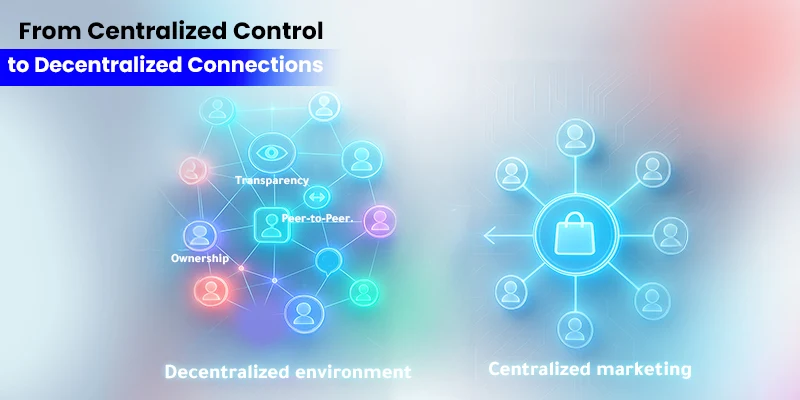
The concepts of Web3 and the metaverse have moved from the realm of speculative fiction to the forefront of strategic business discussions. While the landscape is still nascent and filled with hype, a pragmatic and strategic approach can unlock significant opportunities for community building, brand engagement, and the creation of novel, immersive customer experiences.
For the 2025-26 timeframe, the focus should be on understanding the fundamental principles of these decentralized environments and developing practical, phased strategies for entry and growth.
Practical Marketing Strategies for Decentralized Environments
Marketing in Web3 is fundamentally different from the centralized, platform-dominated world of Web2. The Web3 ecosystem is built on core principles of decentralization, transparency, and user ownership and control over data and digital assets. This shifts the strategic focus away from traditional marketing funnels and toward the cultivation of engaged, self-sustaining, community-driven networks.
Several core strategies are proving effective for brands entering this new space:
- Community Building: This is the paramount activity in Web3 marketing. Fostering a vibrant and engaged community on platforms like Discord, Reddit, and emerging decentralized social media networks is essential. Success requires active and authentic participation, a commitment to listening to and acting on community feedback, and empowering community members to take an active role in the brand’s evolution.
- Educational Content Marketing: Given the complexity of many Web3 concepts, there is a significant opportunity for brands to position themselves as trusted authorities by creating valuable, educational content. Developing clear and accessible blogs, videos, and guides that demystify topics like blockchain, DeFi, and NFTs can build credibility and attract a dedicated audience.45
- Strategic Partnerships: The Web3 ecosystem is highly collaborative. Forming strategic alliances with other established projects, platforms, and influential figures within the space is a crucial tactic for building credibility, expanding reach, and signaling a genuine commitment to the decentralized community.
The following table outlines a phased, strategic approach that traditional brands can use to de-risk their entry into the Web3 space, breaking down the journey into manageable stages with clear objectives, activities, and metrics.
Phase | Strategic Objective | Key Activities | Example Metrics |
Phase 1: Exploration & Education (Months 1-6) | Understand the landscape and identify opportunities | Internal team training, community listening on Discord/Reddit, experimenting with a small-scale NFT project, securing a brand presence in a key metaverse platform | Team knowledge assessment scores, community sentiment analysis, engagement on first NFT drop |
Phase 2: Engagement & Community Building (Months 6-18) | Build an active, engaged community around the brand | Launching a branded Discord server, hosting virtual events or AMAs in the metaverse, collaborating with Web3 influencers, launching a token-gated content hub | Discord server growth and activity, virtual event attendance, influencer campaign reach, number of token holders |
Phase 3: Immersion & Co-Creation (Months 18+) | Empower the community and integrate Web3 into the core business | Establishing a persistent brand experience in the metaverse (e.g., virtual store), launching a token-based loyalty/governance program, allowing community members to vote on product features | Sales from virtual store, governance proposal participation rate, customer lifetime value of token holders vs. non-holders |
This phased approach allows organizations to learn, adapt, and scale their Web3 initiatives in a structured and measurable way.
On-Chain Advertising, NFTs, and Token-Based Community Incentives
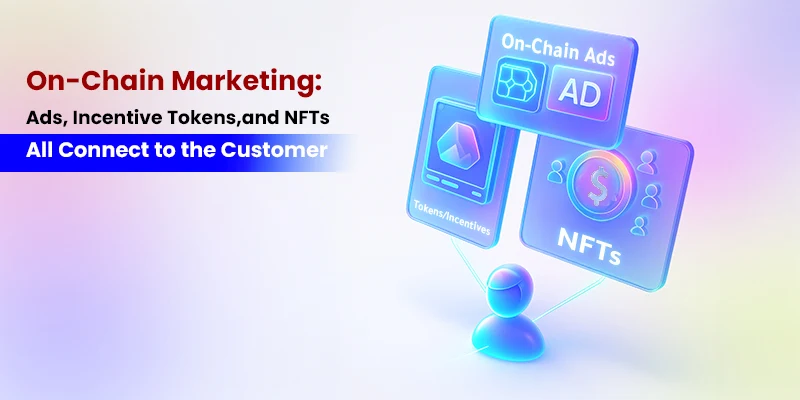
The blockchain technology that underpins Web3 enables entirely new models for advertising and community engagement that are native to the decentralized environment. These models often shift the value exchange, directly rewarding users for their attention and participation.
- On-Chain Advertising: This refers to advertisements that live directly on the blockchain. Examples include using Non-Fungible Tokens (NFTs) as unique, verifiable promotional assets, or creating ad spaces within decentralized virtual worlds (e.g., digital billboards in the metaverse) that can be bought, sold, and traded as tokens.
- Token-Based Incentives: This is a powerful model where users are directly rewarded with cryptographic tokens for engaging with a brand. A prominent example is the Brave browser, which blocks traditional ads but rewards users with its Basic Attention Token (BAT) for opting in to view privacy-respecting Web3 ads. This model explicitly compensates users for their attention, creating a more equitable advertising ecosystem.
- Airdrops and Bounties: These are tactics used to generate buzz and incentivize community participation. An airdrop involves distributing a project’s tokens for free to early adopters or members of a specific community. A bounty campaign rewards community members with tokens for completing specific tasks, such as sharing content on social media, creating user-generated content, or identifying bugs in a new platform.
Building Immersive Brand Experiences in Virtual Worlds

The metaverse, a collective virtual shared space, is rapidly emerging as a significant new channel for customer engagement. The global metaverse economy is projected to exceed $600 billion by 2025, signaling a major shift in how and where consumers will interact with brands.
Pioneering brands are already moving beyond experimentation to build long-term strategies in these virtual worlds. Nike, for example, launched „Nikeland“ on the Roblox platform, creating a gamified brand experience that has engaged millions of users.49 These immersive environments allow for the creation of virtual stores where customers can browse and purchase digital or physical items, and gamified brand experiences that drive deep engagement, particularly with digital-native generations like Gen Z and Millennials.
Beyond customer engagement, the metaverse is also proving to be a powerful platform for internal business functions. Companies like Walmart and Boeing are using VR-based simulations for employee training, a method that has been shown to improve knowledge retention by as much as 75%. The metaverse also enables the creation of fully immersive virtual headquarters, where globally distributed teams can meet, brainstorm, and collaborate in real-time, offering a potential solution to the „Zoom fatigue“ of traditional remote work.
While the idea of advertising in the metaverse is intriguing, a more powerful and sustainable application of Web3 technologies for mainstream brands may lie in a different area: the creation of next-generation loyalty programs. The core mechanics of Web3 marketing, incentivizing and rewarding community participation through tokens, NFTs, and decentralized governance are a supercharged version of traditional loyalty programs. Instead of simply earning points, a loyal customer could earn a cryptographic token that represents a fractional stake in the brand’s community.
This token could grant them tangible benefits, such as voting rights on future product designs, exclusive access to events, or even a share in the community’s collective success. This model has the potential to transform the customer relationship from a purely transactional one to one of co-ownership and shared identity.
The strategic question for CMOs should therefore evolve from „How do we advertise in the metaverse?“ to „How can we use tokens and NFTs to transform our existing loyalty program into a self-sustaining community of brand owners?“ This represents a far more defensible and long-term strategy for building deep, resilient customer relationships in the Web3 era.
The Confluence of Purpose, Ethics, and Brand Storytelling
In the final analysis, the most resilient, respected, and ultimately successful brands of 2025-26 will be those that build their marketing strategies on a foundation of authenticity, purpose, and trust. In a transparent, hyper-connected world, consumers are increasingly making purchasing decisions based not just on product and price, but on a brand’s values and its impact on society.
This requires a genuine commitment to sustainability and social responsibility, a new approach to brand storytelling that leverages the authentic voices of a company’s own employees, and a recognition that these elements are not peripheral PR functions, but core drivers of brand equity and business performance.
Sustainability and Social Responsibility as Consumer Expectations

Ethical marketing has definitively moved from a „nice-to-have“ to a „must-have.“ It is no longer a niche concern but a fundamental driver of mainstream consumer behavior.50 A significant majority of consumers are now actively seeking out brands that prioritize ethical and sustainable practices, and they are willing to vote with their wallets.
Data shows that 57% of consumers are willing to pay more for eco-friendly products, and 70% state a preference for purchasing from companies they perceive as environmentally responsible. Meeting this expectation requires a genuine and holistic commitment, as consumers have become highly adept at spotting „greenwashing“, the practice of making misleading claims about a company’s environmental practices.
A credible ethical marketing strategy must be transparent and encompass the entire operational ecosystem of the brand. This includes everything from the sustainable sourcing of raw materials and the implementation of fair labor practices in the supply chain to the carbon footprint of the company’s digital marketing activities, such as using energy-efficient web servers for hosting its website.
The Power of Internal Influence: Building an Employee Advocacy Engine

In an era characterized by declining public trust in institutions and traditional advertising, the most credible and powerful voice a brand has is that of its own employees. Research consistently shows that people are far more likely to trust information and recommendations from someone they know personally over official corporate messaging. In fact, 93% of people are more likely to trust content shared by a friend or acquaintance. This insight is the foundation of a powerful marketing strategy: employee advocacy.
A formal Employee Advocacy Program (EAP) is a structured initiative that empowers and encourages employees to share company news, product information, and cultural stories through their personal social networks. This approach humanizes the brand, giving an authentic, inside look at the company, and it dramatically amplifies the organic reach of the brand’s message.
The success of an EAP is contingent on several key factors. It must be built upon a positive and supportive company culture where employees feel valued and engaged. It requires clear goals and KPIs to measure its impact, comprehensive training to ensure employees feel confident and understand the guidelines, and a well-defined social media policy that provides clarity on what is appropriate to share.
Leading companies like Salesforce and Cisco have demonstrated the significant return on investment that a well-executed EAP can deliver, both in terms of brand awareness and tangible business results.
Crafting Authentic Narratives that Resonate in a Transparent World

The key to a successful and sustainable employee advocacy program is encouraging authenticity.
The goal is not to turn employees into corporate mouthpieces, but to empower them as genuine brand storytellers. Data shows that social media posts from employees that are personalized with their own commentary or perspective generate 64% more engagement than generic, non-personalized corporate content.
To foster this authenticity, brands should provide their employee advocates with a rich and varied mix of content to share. This should include not only company-centric news and third-party industry content but also, most importantly, content that showcases the company’s unique culture. This can include behind-the-scenes moments from the office, photos from team events, and spotlights on individual employee achievements.
By empowering employees to share these stories, companies provide an authentic, unfiltered glimpse into their values and work environment, which is invaluable for building trust with both potential customers and prospective new talent.
This strategy of leveraging internal influence has a profound implication that extends beyond brand building. A well-executed Employee Advocacy Program can serve as a powerful solution to the dual challenges of building trust and acquiring valuable first-party data in a privacy-first world. As established earlier, trust is the prerequisite for consumers to willingly share their first-party data, which has become the most valuable asset in a post-cookie marketing landscape.39 Employees are the most trusted source of information about a company.
When an employee shares content with their personal network, they are reaching an audience that has a pre-existing layer of trust. A lead that is generated from an employee’s post is therefore inherently warmer and more qualified than a lead from a cold advertisement. When that lead clicks through and willingly signs up for a newsletter or a webinar based on that trusted recommendation, they are providing their first-party data consensually, not as a result of manipulative tactics.
This reframes the EAP from a „soft“ PR or HR initiative into a hard-nosed performance marketing channel. Marketing departments should invest in, manage, and measure their EAP with the same rigor they apply to any other lead and data acquisition channel. The ROI of an EAP should be measured not just in „reach“ and „engagement,“ but in the number of qualified leads generated and the volume of consented first-party data that is added to the CRM. This positions employee advocacy as a core driver of business growth in the trust-driven economy of 2025-26.

